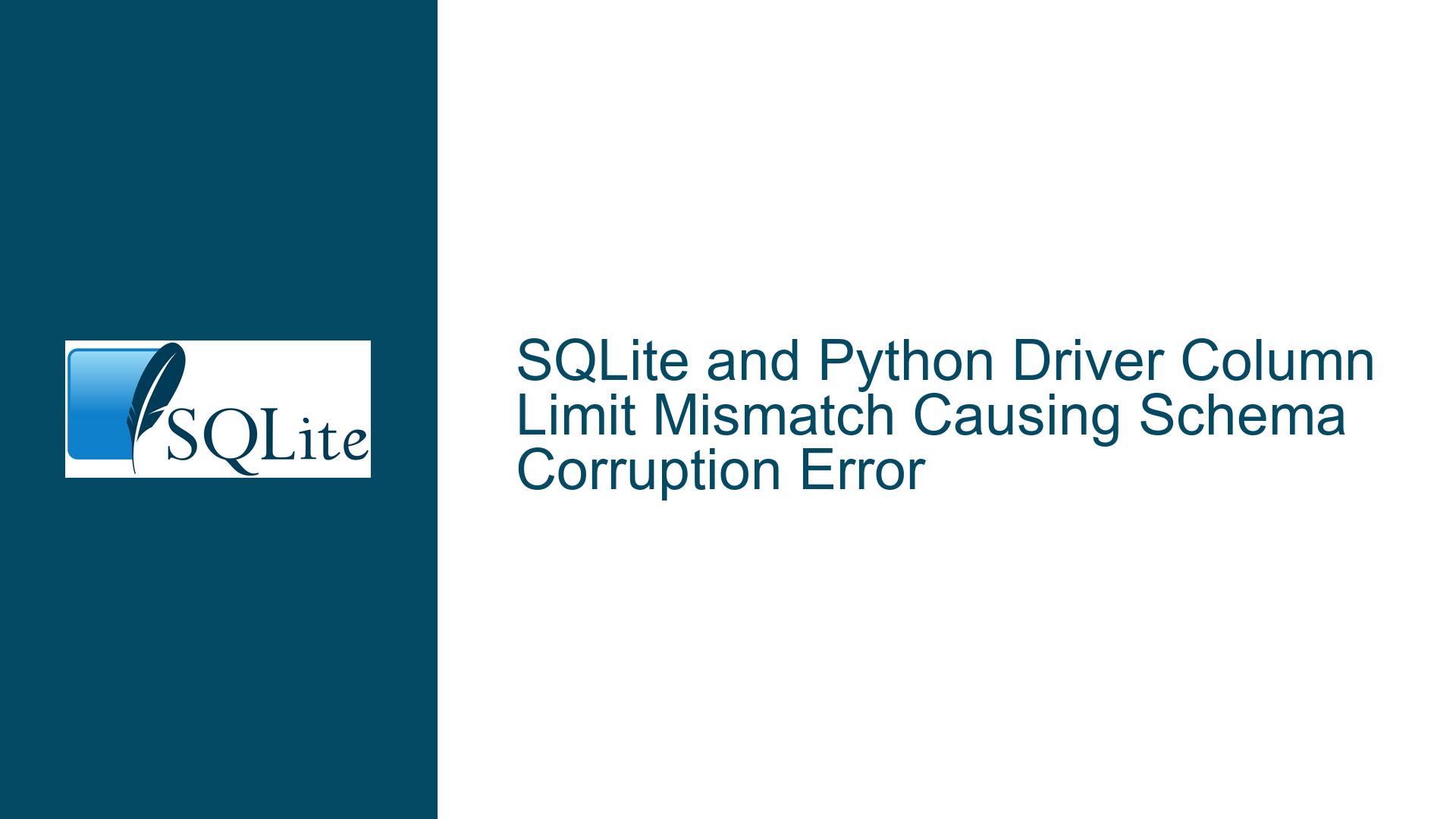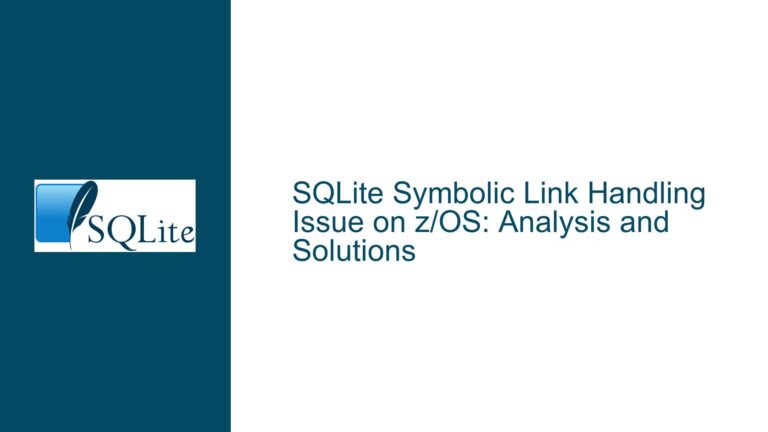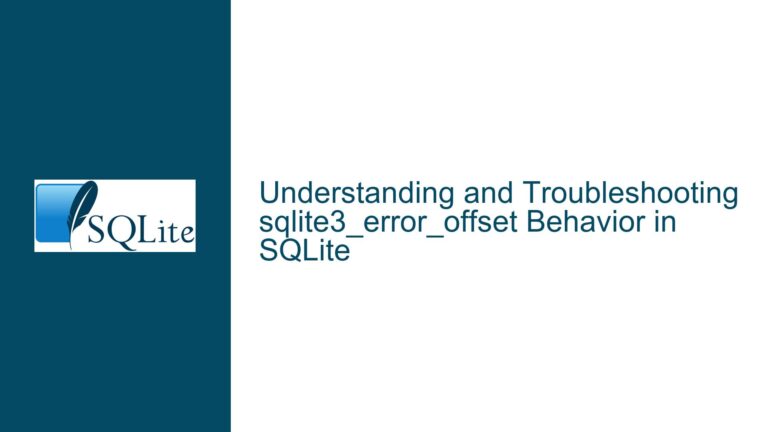SQLite and Python Driver Column Limit Mismatch Causing Schema Corruption Error
Issue Overview: SQLITE_CORRUPT Error When Querying Tables Exceeding 2000 Columns via Python
The core problem arises when attempting to interact with SQLite tables containing more than 2000 columns through Python’s sqlite3 driver. Despite recompiling the SQLite engine with -DSQLITE_MAX_COLUMN=32767 to raise the column limit, users encounter a malformed schema error:
[SQLITE_CORRUPT] The database disk image is malformed (malformed database schema (TableName) - too many columns on TableName)
This error manifests specifically when using Python to execute SELECT queries or INSERT operations on these wide tables – even when querying only a subset of columns. The paradox occurs because:
- SQLite CLI successfully creates/inserts into such tables when compiled with extended limits
- Python’s sqlite3 module rejects operations on these tables despite identical SQL statements
The root conflict stems from version mismatch between SQLite engines used by different components. When the database schema metadata is written by a high-limit SQLite engine (e.g., custom-compiled CLI), but read by a standard-limit engine (e.g., Python’s linked library), schema validation fails catastrophically. SQLite stores column counts in the sqlite_schema table, and lower-limit versions interpret large counts as schema corruption.
Possible Causes: Version Conflicts and Build Configuration Mismatches
1. Python Driver Links to System SQLite Library with Default Limits
Most Python distributions bundle a precompiled SQLite library with default build options (SQLITE_MAX_COLUMN=2000). Even if you recompile SQLite separately, Python may continue using the system library. Verification steps:
import sqlite3
print(sqlite3.sqlite_version) # Shows linked SQLite version
conn = sqlite3.connect(':memory:')
for row in conn.execute('PRAGMA compile_options'):
if 'MAX_COLUMN' in row[0]:
print(row[0]) # Exposes actual column limit
2. Incomplete Rebuild of Python SQLite Bindings
Python’s sqlite3 module (pysqlite3) dynamically links to the SQLite shared library at runtime. Merely recompiling SQLite from source doesn’t guarantee Python will use the new library. Common pitfalls:
- LD_LIBRARY_PATH not configured to prioritize custom SQLite builds
- Static linking not enforced during Python/sqlite3 module compilation
- Multiple SQLite installations causing version ambiguity
3. Schema Validation Cross-Version Incompatibility
SQLite enforces schema consistency checks when opening databases. A table created with SQLITE_MAX_COLUMN=32767 stores metadata indicating 2000+ columns. When a SQLite instance with default limits (2000 columns) attempts to read this schema:
- Parses column count from sqlite_schema table
- Compares against its compile-time SQLITE_MAX_COLUMN
- Triggers SQLITE_CORRUPT error as safeguard against invalid schemas
This protective measure prevents operations on schemas exceeding local limits, even if queries don’t reference excess columns.
Troubleshooting Steps: Aligning SQLite Versions and Resolving Library Conflicts
Step 1: Audit SQLite Versions Across Environments
A. Identify Python’s Linked SQLite Library
ldd $(python -c "import _sqlite3; print(_sqlite3.__file__)") | grep sqlite3
This reveals the shared library path used by Python. Compare with your custom SQLite build location.
B. Verify Column Limits in All Components
Run the Python diagnostic script from "Possible Causes" section. If MAX_COLUMN remains 2000, proceed to Step 2.
C. Check SQLite CLI Version Consistency
sqlite3 :memory: 'PRAGMA compile_options;' | grep MAX_COLUMN
Ensure CLI and Python report identical MAX_COLUMN values when using the same database.
Step 2: Rebuild Python sqlite3 Module with Custom SQLite Library
A. Build SQLite with Extended Column Limit
wget https://www.sqlite.org/src/tarball/sqlite.tar.gz
tar xzf sqlite.tar.gz
cd sqlite/
export CFLAGS="-DSQLITE_MAX_COLUMN=32767"
./configure --prefix=/opt/sqlite_custom --enable-shared
make && sudo make install
B. Recompile pysqlite3 with Custom Library
Python’s sqlite3 module must link against the new library:
git clone https://github.com/ghaering/pysqlite3
cd pysqlite3
export SQLITE3_INCDIR=/opt/sqlite_custom/include
export SQLITE3_LIBDIR=/opt/sqlite_custom/lib
python setup.py build
python setup.py install --user
C. Verify Linkage in Python
Launch Python and confirm:
import sqlite3
print(sqlite3.sqlite_version) # Should match custom build
conn = sqlite3.connect(':memory:')
conn.execute('CREATE TABLE test (' + ','.join(f'c{i} INT' for i in range(2500)) + ')') # Should succeed
Step 3: Isolate Environments Using LD_LIBRARY_PATH or Virtual Environments
To avoid system library conflicts:
A. Runtime Library Override
export LD_LIBRARY_PATH=/opt/sqlite_custom/lib:$LD_LIBRARY_PATH
python your_script.py
B. Conda Environment Isolation
conda create -n sqlite_custom python=3.7
conda activate sqlite_custom
conda install -c conda-forge compilers # Ensure build tools
# Follow Step 2B within this environment
C. Docker Containerization
FROM python:3.7-slim
# Build custom SQLite
RUN apt-get update && apt-get install -y build-essential wget
RUN wget https://www.sqlite.org/src/tarball/sqlite.tar.gz && \
tar xzf sqlite.tar.gz && \
cd sqlite && \
CFLAGS="-DSQLITE_MAX_COLUMN=32767" ./configure --prefix=/usr && \
make && make install
# Rebuild pysqlite3
RUN pip install pysqlite3
COPY . /app
WORKDIR /app
Step 4: Schema Normalization as Long-Term Solution
While technical fixes exist, tables exceeding 2000 columns indicate severe denormalization. Practical normalization strategies:
A. Vertical Partitioning
Split wide tables into multiple related tables:
-- Original table
CREATE TABLE sensor_data (
timestamp INTEGER PRIMARY KEY,
sensor1 REAL,
sensor2 REAL,
... # 2000+ columns
);
-- Normalized schema
CREATE TABLE sensor_types (
id INTEGER PRIMARY KEY,
name TEXT UNIQUE,
unit TEXT
);
CREATE TABLE sensor_readings (
timestamp INTEGER,
sensor_id INTEGER REFERENCES sensor_types(id),
value REAL,
PRIMARY KEY (timestamp, sensor_id)
);
B. Entity-Attribute-Value (EAV) Pattern
For sparse columns:
CREATE TABLE entity_attributes (
entity_id INTEGER,
attribute_name TEXT,
attribute_value TEXT,
PRIMARY KEY (entity_id, attribute_name)
);
C. JSON/Blob Storage for Rarely Queried Data
SQLite’s JSON1 extension enables hybrid approaches:
CREATE TABLE entities (
id INTEGER PRIMARY KEY,
common_columns JSON,
rare_columns JSON -- Stores <2000 fields as JSON
);
-- Query example
SELECT json_extract(rare_columns, '$.column1234') FROM entities;
Step 5: Mitigate Library Version Conflicts in Production
For systems where replacing the system SQLite is risky:
A. Symbolic Link Swapping
sudo mv /usr/lib/x86_64-linux-gnu/libsqlite3.so.0.8.6 /usr/lib/x86_64-linux-gnu/libsqlite3.so.0.8.6.bak
sudo ln -s /opt/sqlite_custom/lib/libsqlite3.so.0.8.6 /usr/lib/x86_64-linux-gnu/
B. AppArmor/SELinux Policies
Modify security policies to allow Python to load custom libraries if blocked by mandatory access control.
C. Static Linking in Python Extensions
Rebuild Python’s _sqlite3 extension with static linking:
cd pysqlite3
export CFLAGS="-I/opt/sqlite_custom/include"
export LDFLAGS="/opt/sqlite_custom/lib/libsqlite3.a -lm -ldl"
python setup.py build
Step 6: Validate Database Portability
After schema modifications, test database files across environments:
A. CLI Compatibility Check
sqlite3 original.db .schema > schema.sql
sqlite3 test.db < schema.sql # Using default SQLite
B. Python Schema Validation Script
import sqlite3
from sqlite3 import DatabaseError
def validate_schema(db_path):
try:
conn = sqlite3.connect(f'file:{db_path}?mode=ro', uri=True)
conn.execute('SELECT * FROM sqlite_schema LIMIT 1')
print("Schema validation succeeded")
except DatabaseError as e:
print(f"Schema invalid: {e}")
Step 7: Monitor Performance Implications
Wide tables incur hidden costs even with increased column limits:
A. Storage Overhead Analysis
Each row stores NULL markers for all columns. For N columns:
- At least ⌈N / 8⌉ bytes per row for NULL bitmap
- Example: 2000 columns = 250 bytes/row just for NULL tracking
B. Indexing Limitations
SQLite limits indexes to 2000 columns by default (SQLITE_MAX_LENGTH). Raising SQLITE_MAX_COLUMN doesn’t automatically increase this.
C. Query Optimization Barriers
The query planner struggles with tables exceeding ~100 columns, leading to suboptimal execution plans. Use EXPLAIN QUERY PLAN to analyze:
EXPLAIN QUERY PLAN SELECT col1234 FROM wide_table WHERE col1 = 42;
Final Recommendations
- Immediate Fix: Rebuild Python’s sqlite3 module against custom SQLite with matching MAX_COLUMN
- Medium-Term: Migrate to normalized schema using partitioning or EAV
- Long-Term: Implement schema review processes to prevent anti-patterns
By methodically aligning SQLite versions across components and addressing schema design flaws, the SQLITE_CORRUPT error resolves while improving database maintainability. Always validate that all database-accessing components use identical SQLite build options when pushing schema changes to production.






